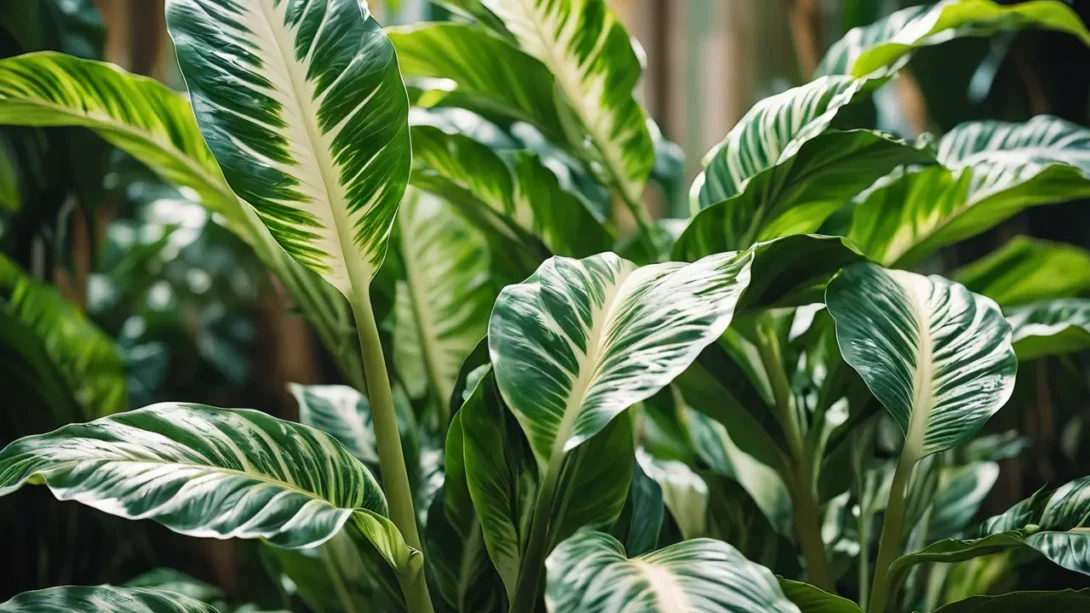Dumb Cane, scientifically known as Dieffenbachia, stands out in the world of houseplants for its striking, patterned foliage and ease of care. This tropical plant not only adds a splash of color to indoor spaces but also purifies the air, making it a favorite among plant enthusiasts. Propagation, the process of creating new plants from an existing plant, opens up a world of possibilities for expanding your collection or sharing with friends and family. In this article, we’ll dive into the methods of propagating Dumb Cane, including stem cuttings in water, stem cuttings in soil, and air layering, providing you with the knowledge to successfully multiply your beloved plant.
Dumb Cane Propagation
Propagation is a cost-effective and rewarding way to expand your garden. Dumb Cane’s robust nature makes it an ideal candidate for propagation, particularly because it can recover quickly from pruning and readily forms new roots. The best time to propagate Dumb Cane is during its active growth period, typically in the spring and summer months, when the plant has the most energy and resources to devote to new growth. To get started, you’ll need some basic tools: sharp, clean pruning shears or a knife, pots with drainage holes, fresh potting mix, and water. Ensuring your tools are clean and sharp minimizes the risk of disease and damage to the parent plant.
Propagation Method 1: Stem Cuttings in Water
One of the simplest and most satisfying methods to propagate Dumb Cane is through stem cuttings placed in water. This method allows you to observe root development firsthand, making it a great educational tool for gardeners of all ages.
- Selecting a Healthy Stem: Look for a healthy, robust stem on your Dumb Cane plant, ideally one with multiple leaf nodes. Leaf nodes are the points on the stem where leaves are attached, and they are where new roots will sprout.
- How to Cut the Stem: Using your clean, sharp pruning shears or knife, make a clean cut just below a leaf node. The cutting should be about 4-6 inches long. Remove the lower leaves to prevent them from rotting when submerged in water.
- Placing the Stem Cutting in Water: Fill a transparent container with room-temperature water and place the stem cutting inside, ensuring at least one leaf node is submerged. Choose a spot for the container that receives bright, indirect light.
- Water Maintenance and Rooting Observation: Change the water every few days to keep it fresh and prevent bacterial growth. Roots typically begin to appear within a few weeks. Watch for root growth and enjoy the process of your cutting developing new life.
- Transitioning the Rooted Cutting into Soil: Once the roots have grown to a few inches long, it’s time to pot the cutting in soil. This transition encourages further growth and helps the plant adapt to its eventual permanent home.
By following these steps, you’ll be able to watch the fascinating process of new roots stretching out into the water and a new plant taking shape. This method not only provides a visual delight but also offers a high success rate for propagating Dumb Cane.
Propagation Method 2: Stem Cuttings in Soil
Propagating Dumb Cane directly in soil is another effective method, particularly beneficial for those who prefer a “plant it and forget it” approach. This method can potentially lead to quicker establishment since the cutting doesn’t need to transition from water to soil.
- Choosing the Right Stem: As with water propagation, select a healthy stem that has several leaf nodes. This will increase the chances of successful rooting.
- Preparing the Stem: Use your clean, sharp pruning shears to cut a 4-6 inch segment of stem, making sure to cut just below a leaf node. Strip the bottom leaves off the stem to expose the nodes, as these will be buried in the soil.
- Selecting the Appropriate Soil Mix and Container: Prepare a pot with drainage holes by filling it with a light, well-draining potting mix. A mix designed for tropical plants or a mixture of peat, perlite, and vermiculite works well for Dieffenbachia.
- Planting the Stem Cutting in Soil: Plant the cutting deep enough so that at least one, preferably two, leaf nodes are buried in the soil. This encourages roots to develop from these nodes.
- Care Tips for Ensuring the Cutting Thrives: Water the soil lightly to settle it around the cutting. Place the pot in a warm location with bright, indirect light. Keep the soil consistently moist but not waterlogged, and consider covering the pot with a clear plastic bag to create a humid microenvironment, mimicking the tropical conditions that Dumb Cane loves.
- How to Tell When the Cutting Has Successfully Rooted: In a few weeks, gently tug on the cutting. A feeling of resistance indicates root development. At this point, care can be adjusted to normal Dieffenbachia maintenance practices.
Propagation Method 3: Air Layering
Air layering is a slightly more advanced, but highly rewarding propagation technique that encourages roots to form on a part of the plant while it’s still attached to the parent. This method is ideal for larger plants that may need pruning or reshaping.
- Explanation of Air Layering: Air layering involves wounding the stem of the plant slightly, applying a rooting hormone, and then wrapping the area with moist sphagnum moss. This is then enclosed with plastic to retain moisture, creating an environment that encourages roots to develop directly on the stem.
- Detailed Steps to Perform Air Layering on a Dumb Cane Plant: Choose a healthy section of stem, preferably with a few leaves. Make an upward slanting cut about one-third into the stem, approximately 6-12 inches from the top of the plant. You can insert a small piece of toothpick or matchstick to keep the wound open. Apply rooting hormone to the cut, then wrap moist sphagnum moss around it. Cover the moss with plastic wrap, securing it with tape or twist ties at both ends to hold the moisture in.
- Care Tips During the Air Layering Process: Keep the sphagnum moss moist by occasionally adding water through the plastic wrap if necessary. Place the plant in a location with bright, indirect light and maintain its usual care routine.
- Removing and Potting the New Plant: After a few months, roots should be visible through the plastic and entwined in the moss. At this point, the new plant section can be cut off just below the root ball and potted in its own container with fresh potting mix.
Air layering not only results in a new plant but also rejuvenates the parent plant, encouraging new growth and a bushier appearance. It’s a fascinating process that allows gardeners to tackle more challenging propagation projects with confidence.
Aftercare for Propagated Dumb Cane Plants
Once your Dumb Cane cuttings have successfully rooted and been potted in soil, the next phase of their journey begins. Proper aftercare is crucial for young plants to thrive and grow into healthy, vibrant specimens.
- Watering Regimen for New Plants: Water newly potted plants thoroughly, allowing the excess to drain away. Thereafter, keep the soil consistently moist but not waterlogged. Overwatering can lead to root rot, while under-watering can stress the young plant.
- Light and Temperature Requirements: Dumb Cane prefers bright, indirect light. Direct sunlight can scorch the leaves, whereas too little light can stunt growth. Aim for a temperature range between 65°F to 75°F (18°C to 24°C), avoiding drafts and sudden temperature changes.
- Fertilization and Repotting Guidelines: Wait at least 4-6 weeks before fertilizing your new plants to allow them to settle in. Use a balanced, water-soluble fertilizer diluted to half strength every 4-6 weeks during the growing season. Repotting should be considered when the plant outgrows its current pot or when roots start to emerge from the drainage holes, usually every 1-2 years.
Troubleshooting Common Propagation Issues
Even with the best care, you may encounter some issues during the propagation process. Here are tips to tackle common challenges:
- Rotting Stem Cuttings: If cuttings start to rot in water or soil, it could be due to too much moisture or a lack of aeration. Ensure the water is changed regularly for water propagation and that the soil is well-draining for soil propagation.
- No Root Development: Sometimes cuttings take longer to root. Patience is key. Ensure the cutting has at least one leaf node submerged in water or buried in soil, and that it’s kept in optimal growing conditions.
- Fungal Diseases: Overly damp conditions can lead to fungal growth. If you notice mold or mildew, reduce watering and improve air circulation around the plant. For severe cases, it may be necessary to start over with a new cutting.
Conclusion
Propagating Dumb Cane (Dieffenbachia) is a rewarding endeavor that allows gardeners to expand their collection and share with others. Whether you choose stem cuttings in water, soil, or try your hand at air layering, each method offers its own set of learning experiences and satisfactions. Remember, the key to successful propagation lies in patience, proper care, and attention to detail. As your new plants grow and thrive, you’ll find the effort well worth it, adding to the joy and beauty of gardening. So, don’t hesitate to experiment with different propagation techniques and enjoy the process of nurturing new life from your existing Dumb Cane plant.




